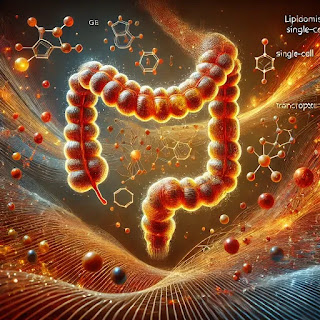The Gut and Cancer: Why Inflammation Might Be the Key

Image credit: https://openai.com/index/dall-e/
For a long time, scientists have
suspected a link between inflammation and cancer. It's like a wound that never
properly heals. This idea, first put forward over a century ago, suggests that
cancer might be the result of ongoing, unresolved inflammation. But what
exactly does this mean for us? And how can we use this knowledge to improve
cancer treatment, particularly for colorectal cancer (CRC)?
Understanding the inflammation process
When your body gets injured, it starts a process to heal itself, and part of that is inflammation. In a healthy body, this inflammation is a temporary thing. It starts with the body producing certain chemicals which cause inflammation, then the body switches to producing chemicals which resolve it and stop the inflammation process. This is called 'lipid class switching'. Think of it like a light switch being turned on then off.
In normal wound healing, your body produces substances that cause inflammation at the start, like leukotrienes, which are made from something called arachidonic acid. Then, it switches to making substances that stop inflammation like lipoxins, which are made from other substances like prostaglandins, specifically PGE2 and PGD2. These lipoxins help to calm things down and start the healing process. However, in cancer, this switch doesn't happen properly, leading to ongoing inflammation.
Colorectal cancer and inflammation
CRC is one of the most common cancers worldwide. Although treatments are improving, many people with advanced CRC still don't survive long. What's really interesting is that recent treatments which use the body's own immune system to fight cancer, have been really successful in some types of CRC. This suggests that the immune system and inflammation play a big part in the growth of the cancer.
Scientists are now looking into the role of fats, or lipids, in CRC. Lipids are essential for many things such as cell signaling, storing energy and making cell walls. It appears that when these lipids become unbalanced in the body it can help cancer to grow. This study has found that in CRC, there's a distinct imbalance of lipids, with too many that promote inflammation and not enough of the ones that resolve it.
What the study found
A detailed analysis was carried out of lipid levels in cancerous and normal tissue from patients with CRC. The study found that in the tumors, there were high levels of substances derived from arachidonic acid that cause inflammation like 5-HETE, LTB4, LTC4, LTD4, and LTE4. At the same time, the substances that resolve inflammation, like lipoxins and resolvins, were very low or absent. This imbalance is a big problem in CRC. The researchers also found that the levels of prostaglandins (PGE2 and PGD2), which are needed to start the switch from inflammation to resolution, were low in about 70% of the tumors. This suggests that the body cannot start the process of resolving inflammation properly. It's like having a light switch that is stuck in the 'on' position.
The study also looked at the genes involved in making these inflammation causing and resolving substances. They discovered that the genes that make the inflammation causing substances were highly active in the tumors, whereas the genes that make the resolving substances were not. Moreover, it was noted that immune cells in the tumor environment, rather than the tumor cells themselves, were mainly responsible for producing many of these inflammation causing substances.
Why does this happen?
The study found that the reason for the lack of pro-resolving lipids may be linked to low levels of PGE2/PGD2 which act as a trigger for the production of anti-inflammatory lipids. Also the receptors for PGE2/PGD2 are reduced in tumors which could be preventing these chemicals from working properly.
What does this mean for treatment?
This new understanding of how inflammation is dysregulated in CRC opens up possibilities for new ways to treat it. The researchers propose something called 'resolution medicine'. This involves either introducing substances which resolve inflammation directly into the body, or using substances that the body can use to create its own resolution substances. Some examples of this could be CBD oil, AKBA, or celastrol which have recently been found to switch on the production of these resolving substances in the body. This approach aims to tackle the chronic inflammation that is fueling the cancer and could help the body resolve inflammation on its own.
In conclusion, this research shows that colorectal cancer is driven by chronic inflammation that is caused by a failure of lipid class switching, which is necessary for normal wound healing, and suggests that by encouraging the production of resolving lipids, it may be possible to slow down or even halt the growth of CRC.
Journal information: https://gut.bmj.com/



Comments
Post a Comment